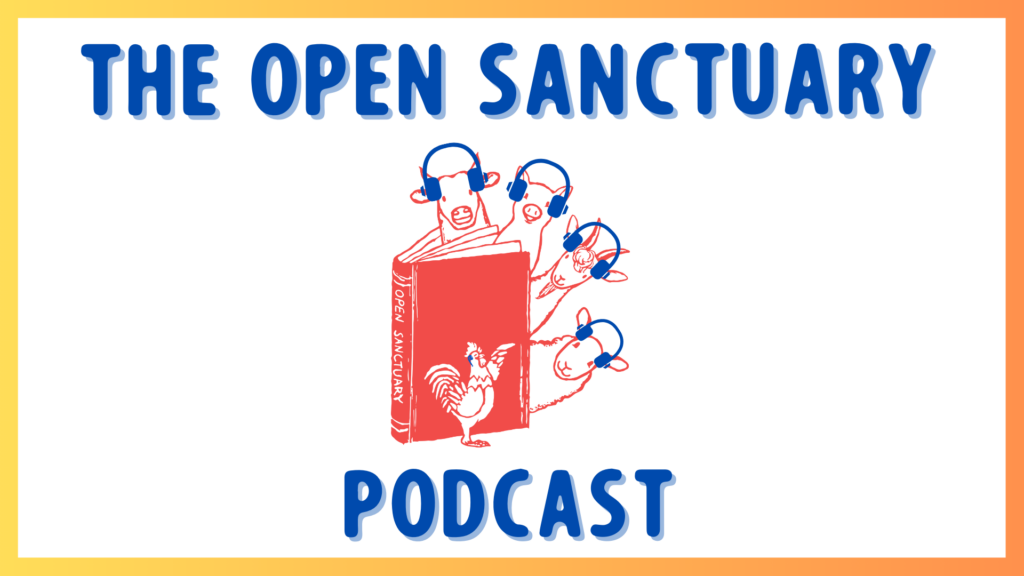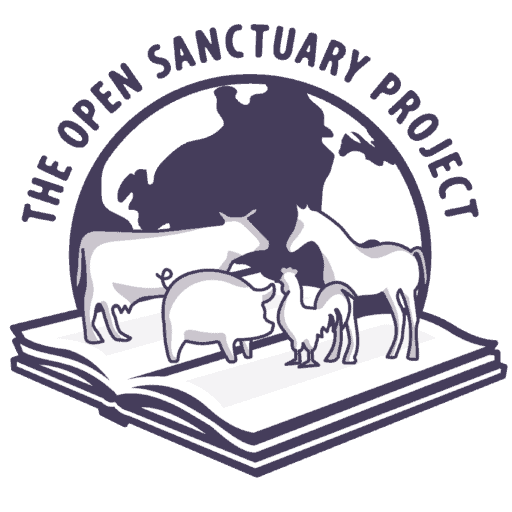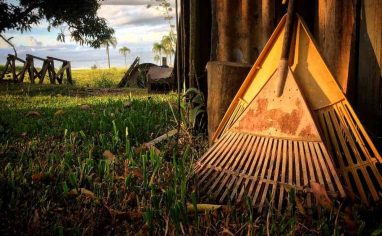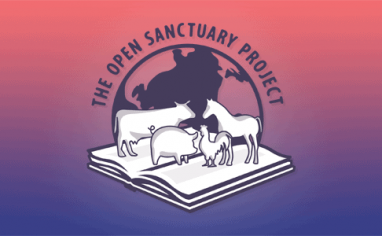
Subscribe To The Open Sanctuary Podcast
If you’d like to get the latest episodes of The Open Sanctuary Podcast, you can subscribe for free on all Podcast platforms, including Apple Podcasts and Spotify!
Episode Notes
In this episode of The Open Sanctuary Podcast, Executive DirectorThe individual formally in charge of final decision making at an organization, who sometimes works closely with the organization’s Board of Directors. Sometimes a Founder is an Executive Director, especially early in a nonprofit’s growth stages. Mckenzee and NonprofitA non-governmental organization whose primary purpose is something other than selling goods or services. Specialist Julia talk about collaboration and cooperation between organizations. They list common pitfalls to relationship building, how to avoid them, and also how to communicate and work together in ways that enhance your capacity! Building community with like-minded organizations is a great way to strengthen our movement and help out humans and non-humans alike!
—
This Episode’s Referenced Open Sanctuary Project Resources:
- Fostering Positive Relationships Between Animal Sanctuaries
- Building And Maintaining A Good Relationship Between Your Animal Sanctuary And Veterinarians
- A Starter Guide To Understanding And Working With Animal Shelters For Animal Sanctuaries
Episode Transcript (Auto-GeneratedThe following content was transcribed through an automated process and may contain transcription errors or misspellings.)
Mckenzee Griffler: Hey there, everybody in the sanctuary world. I’m Mckenzee Griffler. I’m the executive director of the Open Sanctuary Project, and today I’m on the podcast with my friend and colleague Julia Magnus, our nonprofit specialist. And today we’re here to talk about a topic that I think we’ve touched upon a couple of times in different podcast episodes, but Julia and I decided that it would be great to get one recorded just on the topic for people that are interested. So today’s topic is how two different animal organizations, two sanctuaries or like a sanctuary and a rescue or really many animal organizations who share a similar space, how they can develop more positive relationships with one another. And I think most folks, including myself, when I got started in sanctuary some years ago now, I really presumed that all sanctuaries, just by nature of doing such similar work, were natural fits for collaboration with one another. And that sanctuaries would often, you know, they would work together, they would pull resources, all these really wonderful things that we think about when we think about the work that sanctuaries do for animals. And I very quickly realized that this was not necessarily the case with all organizations. And in fact, there were a lot of different points of friction that could come up between multiple organizations that really hindered a collaborative spirit. And we at the Open Sanctuary Project really believe that collaboration when done in a positive way that considers all the variables can really help strengthen the animal protection movement as a whole. And so we just wanted to outline some of the ways that collaboration might not be the easiest thing to happen between multiple organizations that are sharing a space and ways that we can work around those things and address them and really come together as a movement and some of the strengths that we can find when multiple animal organizations work together with a collaborative positive spirit. So Julia, uh, hi first. First of all,
Julia Magnus: Hi.
Mckenzee Griffler: And second of all, hey Julia, what are some reasons why collaboration between two organizations, especially organizations that do such similar things, why might collaboration between these organizations be challenging?
Julia Magnus: Well, I can think of a few different reasons, and one of them is not unique to animal organizations, but really with nonprofitsNon-governmental organizations whose primary purpose is something other than selling goods or services. in general who rely on donations from the public to fund their missionThe stated goals and activities of an organization. An animal sanctuary’s mission is commonly focused on objectives such as animal rescue and public advocacy. and vision, there is a general notion of scarcity that pervades these movements and the thought that resources are fundamentally limited. And so two organizations might be competitors for those resources rather than potential collaborators. And if, for example, you’ve got two sanctuaries that have similar missions and close proximity, there may be a perception that community resources, local community resources are being split in a fashion that might be unsustainable and it may foster a sense of competition between organizations, the sense that you need to convince the public and your supporters that your sanctuary needs it more than the other sanctuary. So that’s one thing. Thing number two is as much as we agree upon within the sanctuary movement and the animal rescueAn organization that helps secure animals from dangerous or unacceptable situations. As organizations, rescues may or may not have dedicated permanent infrastructure for housing animals. movement, sometimes there are differences, and we choose to call those often philosophy of care differences at the Open Sanctuary Project. And this may be where one sanctuary might strongly, strongly believe that a particular care decision protocol or organizational choice should be a universal standard. Everyone should follow this. But you might have a neighbor who disagrees or another organization that disagrees. And these little bits can cause significant, I think one of the things I’ve heard you say, Mckenzee, quite a bit is within sanctuary we agree on 99% of the things but it’s the 1% that makes everybody all mad.
Mckenzee Griffler: Yeah. And so often it’s just that, that one or two little detail of differences that can cause so much friction and drama between two organizations. And I personally think it’s really a shame when we get into those positions as organizations that really do have so much in common.
Julia Magnus: Yeah, I tend to agree with you and that kind of makes me think of another challenge to collaboration at times which is tied into that which is the question of communication and the importance of having really good communication lines set up between organizations because without that, sometimes you’ll get organizations who make assumptions about other organizations without communicating to them to get clarity on what their stance might or might not be on a particular issue and then things can escalate pretty quickly from there into conflict. So I feel like a lot of the things we’ll talk about today relate back to communication, and I think we fully get it, right? Operating an animal sanctuary with any resident population, you know, it could have a large population, could be a small population, there is so much work and mental load that goes into running a sanctuary, not just for caregivers, but also for administrators if your sanctuary has a lot of humans on staff. So, the idea of adding just one more thing and having to think about communicating with external organizations and getting really clear about that might just seem like an extra that’s just not worth that extra bandwidth. But I really do think that it can be so, so important not just for not creating additional friction between organizations, but also just with all of the potential benefits that can come with positive sanctuary communications and beyond that collaboration. So we outlined some things that might cause some challenges between sanctuaries in terms of collaboration or communication. So Julia, what can sanctuaries do to have better communications and have better relationships? And I have to imagine it might be doing the opposite of the things that we just talked about.
Julia Magnus: Yep. It’s opposite world, but happy opposite world. So, I think that often when you’re opening up a channel of communication to an organization you may not know well yet, it’s a great idea to start that by outlining the things that you agree on. So, it’s pretty easy to find a lot of those if you try. I mean, pretty much everyone in sanctuary is going to agree roosters have a hard time that they do not deserve and we like them. We agree that the buddies shouldn’t be harmed or exploited in any way. And so if you go through that exercise of just outlining the things that you agree upon when you start talking, that often just builds a nice foundation for ongoing collaboration and builds strength rather than conflict. So again back to communication, make sure you introduce yourself to other organizations in your area or that you might be working adjacent to and just keep the dialogue open. It’s nice to check in with other groups at times. Just be like, “Hey, did you happen to hear about this situation? How are you all doing? You know, how’s it going?” It doesn’t have to be business all the time. It can be like, “Hey, you know, how’s the summer going for you all?” Um, and just having that just friendly dialogue can help. Even if disagreements arise, just having a little bit of compassion and care for other organizations and individuals that comprise them can help keep tensions from growing. I think one potential caveat to this is to make sure that when you’re communicating with another organization, not to offer unsolicited advice about the way that you do things for certain situations at your sanctuary versus the way that they do things if there is a difference of how you’re organizing yourselves or doing certain tasks. Just because you’re doing something differently doesn’t necessarily mean that one organization is doing things rightly and another one wrongly. But I do think it can come off as condescending if it comes off as offering unsolicited advice, especially if something is working for another organization or they took a long time to develop their protocols, even if it ends up looking a little bit different than yours. Of course, I know that we’re all just interested in making the lives of animal residents better. So it might be something that you feel really passionate about sharing. In that case, I think it can be helpful to approach it more with curiosity or potentially even saying, “Hey, you know about for instance the Open Sanctuary Project. We found that this particular resource on drainage was really helpful for us and it helped us tackle a lot of challenges that we were having with XYZ.” And then you can have it be open to a not necessarily saying that they came up with this brilliant thing that you know you should be doing or else you’re a bad organization, but also hopefully it can create a dialogue channel where if they are doing something differently for a different reason, maybe your organization could learn from that or maybe you’ll understand why they’re making that choice. And I think that comes back to the spirit of collaboration rather than creating friction through assumptions.
Mckenzee Griffler: Yeah, I totally agree. I’ve often found it handy to just be like, “Oh, I saw you were dealing with this issue. Here’s a resource that we liked.” And it’s no judgment. We’re nonpartisan here. We aren’t endorsing or condemning anyone. These are just things that we have researched and worked on which we think might be helpful at OSP. And so having that kind of thing often sidetracks the potential conflict that might come if one organization is dealing with a high emotion, high stakes situation and another one’s like, “Well, this is what you should do,” versus, “Here’s some information.” There are some other challenges too, which also relate often to communication. One might have to do with scheduling. So many organizations tend to have events of different kinds, fundraising events. They might have in-person events, they might be doing tabling, things like that. It can get tricky if you have another organization in proximity who’s also doing events. And so, it’s a great idea to share with other organizations what events you’re doing and when they’re timed. And this way, you can kind of ensure that you’re neither splitting support or stepping on toes. But also, if you get along well, it may be that you could hold events together. So, you know, you might decide, and I’ve seen this recently, some sanctuaries relatively close to me have decided to hold sanctuary solidarity events, which is a lovely thing, and they’ve had these joint events that they’ve done joint fundraising at. The one little tip there is that if there is going to be joint fundraising, again, communication is key in advance and try and create a shared understanding in writing before you have the event so everyone’s clear on how those funds are going to be split up. Another one to do with communication. We’re all familiar with those situations where you have the one person who’s messaging, who is asking to surrenderThe act of transferring guardianship of an animal to a person or organization, especially via legal contract. an animal, trying to place an animal, and you are at capacity, cannot do it. And so, you know, what do you do? The next question they have is, “Well, where else could I ask?” It may be tempting just to say, “Oh, we’ll try the organization in the next county over.” The thing about that is that receiving these kinds of requests is a burden. It’s hard to receive requests to help when you are at capacity or even if you aren’t trying to figure out how you’re going to make it work. It’s a lot. It’s a lot. It’s work. And it’s usually a good idea before you refer somebody to another organization to ask their permission if you can do that so that at least they’re aware that this might happen versus getting the random message saying, “Oh, the rooster rescue in Chicago just sent me to you and they say I should ask you.” That’s just a note.
Julia Magnus: Yeah, I really have to underscore this one that it’s really important to ask another organization if they’re amenable to having surrender referrals because not only does sending somebody to another organization create more work for that other organization, especially, you know, the mental toll of saying no if they can’t accommodate this rescue request. But it can also just feel really bad to hear from another organization that they created this assumption that it would be okay to just send people their way, especially people that might be really desperately seeking a surrender and all of the tough emotions that can be involved with having to say no or having to refer away. So just as a general rule, we think it’s really important that part of those communication channels that you have on another sanctuary is saying, “Hey, if we get a request that we can’t accommodate, is it okay that we send folks your way or would you rather that we didn’t?” So, Julia, I have to imagine that having positive relationships between two or more animal organizations doesn’t necessarily just mean that communication is good between organizations. There has to be a lot of benefits that can come out of these positive collaborations. You want to talk about a few of them?
Julia Magnus: There are so many things. One thing that’s big is sharing transport connections, networks, and creating transport chains together. Even in situations where neither of you have capacity to potentially take a new resident, you may be able to help that resident on their freedom ride to another organization. So, sharing those volunteers because transport volunteers, good ones, are awesome. And that’s a great way to share resources if you have different specialties or different kinds of expertise. Say one sanctuary is really good with birds. Another one is really good with goats. I’ve definitely been in a situation where suddenly a goat and I don’t know anything about goats. So I’m like, “Uh, let me call my friend who does know,” and then gotten a lot of useful help that way. It also helps to share information about caregivers like farriersIndividuals who provide hoof and trimming care, especially for horses or cows. or shearers or veterinarians, and talking about your experience with them can often be helpful, as well as knowledge about vendors. And also think about your residents. Sometimes there are situations where residents might need a buddy and they might need help finding their perfect match. So playing matchmaker together with other organizations can often be a really good way to find forever friends for residents in need of them. If your area has certain issues going on, weather conditions. If there are medical threats like HPAI is the one that comes immediately to mind always. You can share knowledge about what’s going on in your area and also stay in touch about other community developments like say there’re proposed zoning changes or something like that. You can talk about that, maybe coordinate together to advocate in a way that’s necessary for you both.
Mckenzee Griffler: Yeah. And I think it’s important to also point out that these things apply to a lot more than just other animal-based organizations in your area. Creating good relationships with other organizations that might share similar values even if they aren’t directly like a similar mission can really go a long way. Not just with creating, you know, just a better community engagement and maybe getting more volunteers or supporters, but also just creating a real shared sense of collaborative spirit between your organizations that can lead to just really incredible things in communities well beyond just thinking about, “Oh, what am I going to get out of helping this organization?” Working together with other organizations in a spirit of mutual aid and collaboration can just create such good in a community. So whether it’s adjacent environmental groups or food justice groups or gardening and permaculture groups or even art groups. There’s just so many ways that organizations can get creative and see, “Oh well, who else is in this space? What are they up to? What are their values? And where do we have commonalities?” And I think again, you know, this is something that takes genuine work and it takes genuine spirit of communication and collaboration, but just looking around and seeing what organizations are in your area and doing things that you can see some synchronicity with can be a really incredible transformative space. I will say that there is always, of course, the possibility that for whatever reason, not casting blame on who did what or why, but sometimes there just might be a point where you realize, “I just can’t seem to create a positive relationship with this organization that’s in relative proximity to me.” So, Julia, what are we supposed to do at that point? That’s always a not fun one, but it happens.
Julia Magnus: And I would say the one thing I would really want to avoid is a public fighting match. So, I think that if you encounter that situation, figuring out internally that you want to adopt a policy of public neutrality is a good idea. So, this could include things like, “Let’s just not talk about negative things about this organization to the public,” and “Let’s not do blasts on social media,” including things like vague booking which is just sort of, well, you know, making a statement about this thing generally but not naming names, “Let me complain about this.” Those things don’t really look very good, and in general, if you’re an organization that is supported by the public and meant to do a public purpose. It’s not really a great use of time or energy to spend time starting fights on social media or starting fights with other organizations. People see that, and it’s kind of a bummer. It really harshes the mellow of folks who’d like to support you. So, I would recommend against that. The public bickering doesn’t help animals at all. It just harms the residents who need your support and just lowers the perception of maybe even the community as a whole. So what happens though if the other organization doesn’t take the high road and makes a choice to critique you for example on socials? Just remember that people will be paying attention, and it’s usually better not to engage and take the bait and get into the fight as much as reality television might indicate otherwise when it comes to serving public purposes. I would say that most community members and supporters would typically favor calm over calamity.
Mckenzee Griffler: I would definitely agree. I think that sometimes this is an unfortunate reality in the sanctuary world, but the more that you can not engage in that sort of discourse, especially public, especially in the comments section, I think it’s going to serve at least your organization well to be able to maintain that level of professionalism and hopefully will help diffuse tensions a little bit with whatever is going on with the other organization.
Julia Magnus: Yep, totally agree. And it’s just also a spiritual drain. I mean, we have enough in sanctuary and direct caregiving. Do we really want to be scrolling through every single comment, hitting refresh, refresh on a social media post? Is that really going to make us feel better at the end of the day? I mean, for me, I’m just trying to get through a week without looking at the comment section. And that’s challenging, but boy, do I feel better at the end of the day. And ultimately, I think we can all agree that if we can find commonality with other organizations, even organizations we might not fully agree with, it’s just an opportunity for us to have just a little bit more peace carved out in our lives and a little bit more ease, especially in the sanctuary world which is already very challenging and very complex as it is.
Mckenzee Griffler: Yeah. And I would even go so far as to say is when you can have a positive collaborative relationship with another organization. You and I have done podcasts on capacity. It’s a capacity building exercise. There are things you can do with positive relationships that you can’t do by yourself. So consider that the investment of time and energy to build positive relationships is not only just going to make your life easier, it in terms of just energy and avoiding negativity, it’s also just potentially going to help you save lives that you might not have been able to reach otherwise.
Julia Magnus: Absolutely.
Mckenzee Griffler: Well, on that positive note, I would say that we’ve covered the basics of this topic a fair bit and so we’re going to leave it there because we know that some of y’all sometimes appreciate when these episodes are a little bit shorter, so we won’t ramble on forever. Of course, if you’d like to learn a little bit more about this topic and so many more topics, you can find links to relevant resources at the Open Sanctuary Project in the show notes of this very podcast that you’re listening to. And I just want to thank Julia for giving us the time to discuss this very important topic. And if you are so inclined, we would love to hear from you in the comments section, the aforementioned comment section. Let us know how this podcast is working for you. Give us a five-star rating on Apple podcast and all that good stuff. Share it with another sanctuary, someone that you do want to collaborate more with. Maybe this would be a good thing to send to another organization. I would like to certainly hope so. And if you’d like to support our mission, you can find a link in the show notes for that as well. We are of course also an organization and we greatly accept any support that you might be willing to offer us, whether that is a share or a five-star rating or a donation. And that’s about all I have today. Thank you once again, Julia, and thanks for listening to the Open Sanctuary Podcast.

Got A Podcast Idea? Contact Us!
If you have a topic or question you’d love to hear our staff address on The Open Sanctuary Podcast, please get in touch via our contact form!








